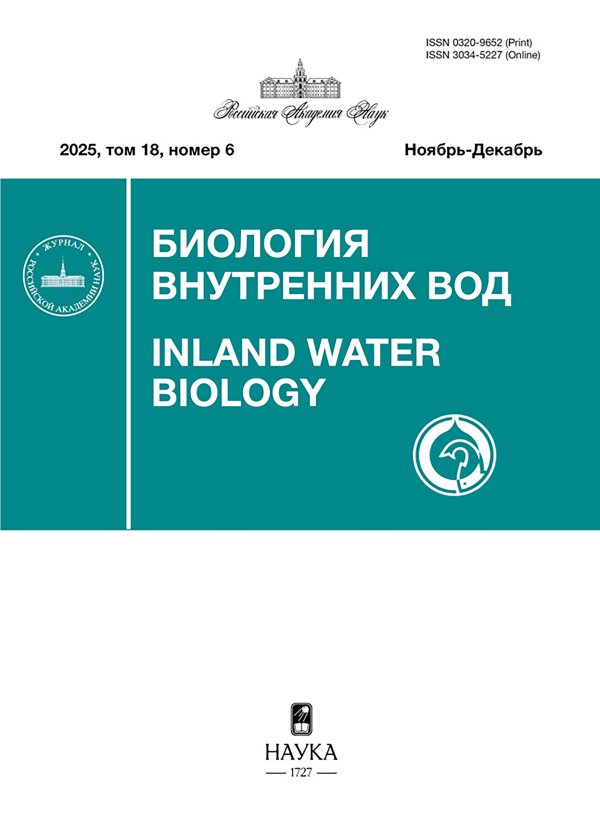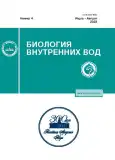Связь плодовитости с количеством позвонков у плотвы Rutilus rutilus Рыбинского водохранилища
- Авторы: Комова Н.И.1
-
Учреждения:
- Институт биологии внутренних вод им. И.Д. Папанина Российской академии наук
- Выпуск: № 4 (2023)
- Страницы: 457-463
- Раздел: БИОЛОГИЯ, МОРФОЛОГИЯ И СИСТЕМАТИКА ГИДРОБИОНТОВ
- URL: https://journals.rcsi.science/0320-9652/article/view/134904
- DOI: https://doi.org/10.31857/S0320965223040125
- EDN: https://elibrary.ru/RVVQDQ
- ID: 134904
Цитировать
Полный текст
Аннотация
Приведены данные по числу позвонков в отделах позвоночника в разных по относительной плодовитости группах плотвы. Среднее значение числа позвонков в туловищном отделе оказалось наименьшим у низкоплодовитых рыб. При сравнении средних значений относительной плодовитости у самок с разным числом позвонков в отделах позвоночника также выделилась группа низкоплодовитых рыб. В ней особи, имевшие 17 позвонков в туловищном отделе, обладали относительной плодовитостью статистически достоверно ниже, а имевшие 16 в хвостовом и в сумме 40 позвонков в позвоночнике – достоверно более высокой плодовитостью, чем особи с другим числом позвонков в этих отделах. У высокоплодовитых самок никаких различий по плодовитости между рыбами, имевшими разное число позвонков в отделах, не отмечено.
Об авторах
Н. И. Комова
Институт биологии внутренних вод им. И.Д. Папанина Российской академии наук
Автор, ответственный за переписку.
Email: komovanadiv@yandex.ru
Россия, Некоузский р-н, Ярославская обл., пос. Борок
Список литературы
- Анохина Л.Е. 1969. Закономерности изменения плодовитости рыб на примере весенне- и осенненерестующей салаки. М.: Наука.
- Баканов А.И., Кияшко В.И., Сметанин М.М., Стрельников А.С. 1987. Уровень развития кормовой базы и рост рыб // Вопр. ихтиологии. Т. 27. Вып. 4. С. 609.
- Володин В.М. 1963. Плодовитость плотвы Rutilus rutilus (L.) в Рыбинском водохранилище // Вопр. ихтиологии. Т. 3. Вып. 2(27). С. 266.
- Володин В.М. 1982. Плодовитость массовых видов рыб Рыбинского водохранилища. 3. Плодовитость плотвы // Биология внутренних вод: Информ. бюл. № 54. Л.: Наука. С. 47.
- Володин В.М. 1983. Некоторые аспекты изучения плодовитости рыб // Пресноводные гидробионты и их биология // Тр. ИБВВ АН СССР. Вып. 48(51). Л.: Наука. С. 151.
- Герасимов Ю.В., Столбунов И.А., Лeвин Б.А. и др. 2015. Плотва // Рыбы Рыбинского водохранилища: популяционная динамика и экология. Ярославль: Филигрань. С. 263.
- Зиновьев Е.А., Треногин А.С. 2005. Плодовитость плотвы Rutilus rutilus (L.) в бассейне р. Камы // Вестн. Пермского ун-та. Биология. Вып. 6. С. 86.
- Изюмов Ю.Г., Володин В.М., Касьянов А.Н., Яковлев В.Н. 1983. О наследственной обусловленности плодовитости плотвы Рыбинского водохранилища // Тр. ИБВВ АН СССР. Вып. 48(51). С. 163.
- Изюмов Ю.Г., Касьянов А.Н. 1995. О наследственной обусловленности числа позвонков у плотвы Rutilus rutilus // Вопр. ихтиологии. Т. 35. № 5. С. 594.
- Кирпичников В.С. 1987. Генетика и селекция рыб. Л.: Наука.
- Кожара А.В., Маврин А.С., Мироновский А.Н. 2020. Структура фенетического разнообразия и систематика красноперки Scardinius erythrophthalmus (Cypriniformes, Cyprinidae) водоемов и водотоков России и сопредельных стран // Биология внутр. вод. № 6. С. 538. https://www.doi.org/10.31857/S0320965220060121
- Комова Н.И. 2005. Внутривидовые особенности морфофункциональных и биохимических показателей фитофильных рыб Рыбинского водохранилища: Дис. … канд. биол. наук. Борок. 186 с. https://www.dissercat.com/content/vnutrividovye-osobennosti-morfofunktsionalnykh-i-biokhimicheskikh-pokazatelei-fitofilnykh-ry
- Комова Н.И. 2011. Динамика изменения диаметра ооцитов у плотвы Rutilus rutilus (Cyprinidae) в нерестовый период // Рыбн. хоз-во. № 5. С. 83.
- Мироновский А.Н. 1991. Особенности изменчивости и популяционной структуры некоторых карповых рыб Волго-Каспийского и сопредельных районов. 1. Популяционная подразделенность // Вопр. ихтиологии. Т. 31. Вып. 4. С. 576.
- Чеботарева Ю.В. 2018. Аномалии позвоночника и позвонковые фенотипы у сеголеток и двухлеток плотвы Rutilus rutilus (L.) (Cyprinidae, Cypriniformes), развившихся из одной выборки эмбрионов // Тр. ИБВВ РАН. Вып. 84(87). С. 58.https://doi.org/10.24411/0320-3557-2018-10019
- Чеботарева Ю.В., Изюмов Ю.Г. 2021. Межгодовая изменчивость морфологических признаков сеголеток плотвы Rutilus rutilus (Cyprinidae) из прибрежья Рыбинского водохранилища у поселка Борок (Ярославская область) // Вопр. ихтиологии. Т. 61. № 6. С. 635. https://doi.org/10.31857/S0042875221060059
- Шатуновский М.И. 2006. Некоторые закономерности возрастной и географической изменчивости плодовитости у рыб // Изв. РАН. Сер. Биол. № 2. С. 244.
- Шатуновский М.И., Рубан Г.И. 2009. Экологические аспекты возрастной динамики показателей воспроизводства рыб // Экология. № 5. С. 339.
- Aguirre W.E., Walker K., Gideon S. 2014. Tinkering with the axial skeleton: Vertebral number variation in ecologically divergent three spine stickleback populations // Biol. J. Lin. Soc. Lond. V. 113. Is.1. P. 204. https://doi.org/10.1111/bij.12316
- Ando D., Mano S., Koide N., Nakajima M. 2008. Estimation of heritability and genetic correlation of number of abdominal and caudal vertebrae in masu salmon // Fish. Sci. V. 74. Is. 2. P. 293. https://doi.org/10.1111/j.1444-2906.2008.01531.x
- De Clercq A., Perrott M.R., Davie P.S. et al. 2018. Temperature sensitive regions of the Chinook salmon vertebral column: Vestiges and meristic variation // J. Morphol. V. 279. Is. 9. P. 1301. https://doi.org/10.1002/jmor.20871
- Kiso S., Miyake T., Yamahira K. 2012. Heritability and genetic correlation of abdominal and caudal vertebral numbers in latitudinal populations of the medaka Oryzias latipes // Environ. Biol. Fish. V. 93. Is. 2. P. 185. https://doi.org/10.1007/s10641-011-9904-1
- Komova N.I. 2016. Comparative analysis of generative parameters of the roach Rutilus rutilus (L., 1758) in the Volga reach of the Rybinsk reservoir // Inland Water Biol. V. 9. № 3. P. 289. https://doi.org/10.1134/S1995082918030069
- Krylov V.V., Chebotareva Yu.V., Izyumov Yu. G. 2016. Delayed consequences of extremely low-frequency magnetic fields and the influence of adverse environmental conditions on roach Rutilus rutilus embryos // J. Fish Biol. V. 88. № 4. P. 1283. https://doi.org/10.1111/jfb.12869
- Lindsey C.C. 1988. Factors controlling meristic variation // Fish Physiol. V. XI B. San Diego: Academic Press. P. 197.
- Maxwell E.E., Wilson L.A.B. 2013. Regionalization of the axial skeleton in the ‘ambush predator’ guild – are there developmental rules underlying body shape evolution in ray-finned fishes? // BMC Evol. Biol. V. 13. № 265. P. 1. https://doi.org/10.1186/1471-2148-13-265
- Ward A.B., Mehta R.S. 2014. Differential occupation of axial morphospace // Zoology. V. 117. Is. 1. P. 70. https://doi.org/10.1016/j.zool.2013.10.006
- Witten P.E., Hall B.K. 2015. Teleost skeletal plasticity: mo-dulation, adaptation, and remodeling // Copeia. V. 103. № 4. P. 1. https://doi.org/10.1643/CG-14-140
- Wong S.F.L., Agarwal V., Mansfield J.H. et al. 2015. Independent regulation of vertebral number and vertebral identity by microRNA-196 paralogs // Proceedings of the National Academy of Sciences [PNAS]. V. 112. № 35. P. 1. https://doi.org/10.1073/pnas.1512655112
- Yamahira K., Nishida T. 2009. Latitudinal variation in axial patterning of the medaka (Actinopterygii: Adrianichthyidae): Jordan’s rule is substantiated by genetic variation in abdominal vertebral number // Biol. J. Lin. Soc. Lond. V. 96. P. 856.
- Yamahira K., Nishida T., Arakawa A., Iwaisaki H. 2009. Heritability and genetic correlation of abdominal versus caudal vertebral number in the medaka (Actinopterygii: Adrianichthyidae): genetic constraints on evolution of axial patterning? // Biol. J. Lin. Soc. Lond. V. 96. P. 867.
Дополнительные файлы











